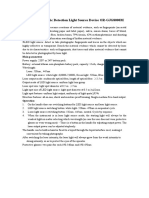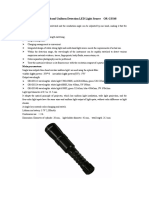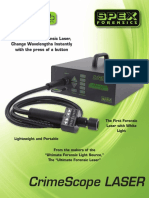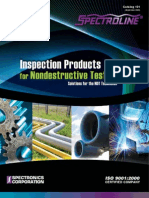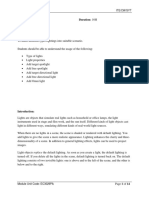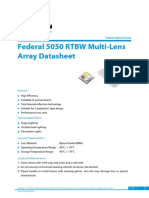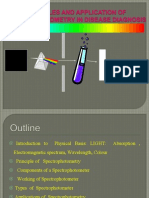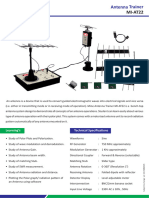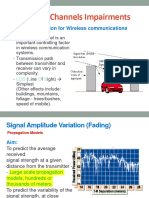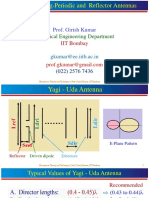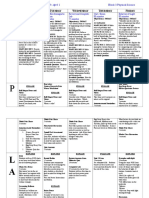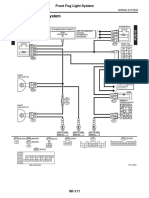TI03.
08-582ENG-REV7 Copyright© 2018 by SIRCHIE
All Rights Reserved.
TECHNICAL INFORMATION
megaMAXX™ ALS System
Catalog No. MMX300
Application Alternate light sources are used to identify evidence normally invisible to the
naked eye. Uses range anywhere from the collection of fingerprints, to the
identification of bodily fluids, to distinguishing between authentic and forged
documents.
INFORMATION
Using only conventional lighting in the forensic examination of a
crime scene cannot reveal all the evidence that may be present. In
fact, the type of evidence itself and what it consists of, as well as the
surface containing it, can prohibit its view under conventional light.
The use of what is termed “alternate light sources”, however, can
reveal this otherwise hidden or overlooked evidence through absorp-
tion, diffused deflection, and photoluminescence.
100 HUNTER PLACE, YOUNGSVILLE, NC 27596 USA
Ph: (919) 554-2244, (800) 356-7311 • Fax: (919) 554-2266, (800) 899-8181 • Web: www.sirchie.com • Email: sirchieinfo@sirchie.com
1 of 12
�TI03.08-582ENG-REV7
The megaMAXX™ Alternate Light Source System is designed to assist the investigator at the crime
scene or in the lab. The kit consists of handheld machine aluminum LED light sources that emit light in
a controlled spectrum centered at the labeled wavelength (365 - 625nm). The kit also includes band filter
goggles for viewing the photoluminescence effect of the evidence or forensic treatments used for latent
evidence detection. (Camera band filters are not included in this kit but are available separately in mul-
tiple filter sizes ranging from 52mm to 82mm.)
2 of 12
� TI03.08-582ENG-REV7
Specifications • UV Light Source: 365nm
• Visible Light Sources: (455nm, 470nm, 505nm, 530nm, 590nm, 625nm, White)
• Dimensions: 6.25" x 1.25"dia. (15.9cm x 3.2cm dia.) for UV light; 5.25" x .75" dia. (13.3cm x 2cm)
visible lights
• Weight w/batteries: 5.1 oz. (144.6g)
• Construction: Machine Knurled Black Anodized Aluminum for UV light
Machined Aluminum for Visible lights
• Switch: Push-button ON/OFF on end cap
• LED: (1) 1-watt UV LED for UV light; (1) 3-watt LED per visible light; +50,000 hrs. life
• Batteries: (2) CR123 Lithium’s per Visible light
(1) 18650 Rechargeable (UV light)
megaMAXX™ Light Diffuser
• Dimensions: 1.06"L x 1.56" dia. (2.7cm x 4cm dia.)
• Weight: .6 oz (17g)
• Construction: Delrin
MMXPOD megaMAXX™ Tripod
• Dimensions: 14"H
• Weight: 11.2 oz (9.1g)
• Construction: 3 legs w/black anodized aluminum base; flexible gooseneck with mounting
clip
Background on ALS Technology
Alternative light sources, sources that produce specific wavelengths of light, have been used in forensic
investigation since the introduction of the first Argon ion laser in the 1970's. In the 1980's portable lasers
were developed to deliver these wavelengths at the crime scene. The 1990's brought high intensity xenon
arc lamps, that when used with proper band filters, could deliver a wide range of wavelengths, from ultra-
violet (below 400nm) to infrared (above 700nm), and all divisions of visible light. Now, SIRCHIE utilizes
LED (light emitting diode) technology to deliver alternative light in an accurate and easy to transport
package.
3 of 12
�TI03.08-582ENG-REV7
Alternative light sources can aid the criminal investigator in their assessment of the crime scene, allow-
ing them to see evidence that before may have gone unnoticed. Alternative light sources can be used
in two ways to identify evidence, through fluorescence and in combining fluorescence with filtration.
Fluorescence is when an object absorbs light energy and then re-emits that energy at a different, usu- ally
higher, wavelength. Pure fluorescence can be observed when a UV light source is used to examine bone
fragments or bodily fluids and they are seen as having a bluish glow versus their surroundings, due to
the energy being emitted at the higher wavelength (450nm blue vs. 400nm UV). Using wave- lengths in
the visible light region (410nm to 700nm) usually requires filtration to remove background colors and
clearly show the desired evidence. A good example is the use of fluorescent powder, such as SIRCHIE
REDescent™ No. LL701. A print that is identified on a multicolored surface would be dif- ficult to photo-
graph. Using the fluorescent powder, the fingerprint can be dusted, and then viewed with
an alternative light source. In the case of REDescent™ powder, the absorption peak is in the 450-460nm
region, so when exposed to the megaMAXX™ 455nm source light, it absorbs and then remits light in
the 590nm-620nm region. The observer can wear orange barrier goggles (No. BMS300), which filters the
background being illuminated by the blue light (450nm-460nm) and only allows the orange region to be
seen (590-620nm), and thus separates the print from the background. In this same way, the fingerprint
can now be photographed using a 52mm orange barrier filter. Please refer to the usage chart for more
examples of how the ALS can be used at the crime scene.
MMX300 COMPONENTS
Seven Visible Light Sources
The seven (7) megaMAXX™ Visible Light Sources are identical
in size and shape. Measuring 5.25" in length with a barrel diameter
of only .75", these hand-held lights each weigh a mere 3.55 oz. with
batteries. Each one is fitted with a very high intensity, 3-watt Light
MMX455nm
4 of 12
� TI03.08-582ENG-REV7
Emitting Diode (LED) constructed to provide visible light at its specific frequency. The power for the vis-
ible lights is supplied by two (2) CR123 Lithium batteries.
LED technology means there are no filters mounted on these lights. Lights with filters require a single
white light source and a filter to remove all but the desired light wavelength. Light loss
occurs using the filter method of delivery.
megaMAXX™ Light Diffuser
Due to the intensity of these lights, certain applications may require a less intense, softer
light , such as photography of latent prints. To provide softer light, we have engineered a LIGHT DIFFUSER
diffuser that easily slips on and off the seven (7) visible light sources.
ForensiTORCH™ UV Light
In the preliminary examination and location of physi-
cal evidence, an ultraviolet
UVFT100
light source should always
be employed. The 365nm ForensiTORCH™ UV Light (UVFT100A) features
a 1-watt UV LED and is powered by one (1) rechargeable 18650 battery. A
single-slot charger is supplied in the kit for this battery.
megaMAXX™ Tripod
There are many times you will need to have both hands free to process an
area or item of forensic interest. With this in mind, SIRCHIE has devised the
megaMAXX™ Tripod (MMXPOD). This Light Support features a flexible
gooseneck extension with a maximum height of 14". Not only does this allow
MMXPOD
for precision positioning of the light over the area being processed, but aids in
facilitating photographs as well.
5 of 12
�TI03.08-582ENG-REV7
The only assembly required is to attach the legs (contained in the center com-
partment of your case) to the base of the tripod as shown to the left. With the
tripod assembled for use, simply snap the light into the clip at the top of the
tripod and position the flexible gooseneck extension as desired.
Barrier Filters and Goggles
797GV BMS300 FAL207 FAL208
Visible light sources can sometimes overpower any present fluorescence and a barrier filter must be
used to block it in order to see the fluorescence. The
megaMAXX™ System provides barrier filter goggles in
Yellow, Orange and Red. To photograph the resultant fluores- OPTIONAL BARRIER FILTERS
cence, similarly colored barrier filters (sold separately) must (sold separately)
be placed over the camera lens (refer to Usage Chart).
When using the 365nm ForensiTORCH™ UV Light, it is not necessary to use barrier goggles, as UV
fluorescence re-emits as visible blue light. However, UV light can cause damage to the eyes, so it is rec-
ommended to wear the UV filtering goggles (797GV).
OPERATION
Battery Installation
Prior to using the lights in your MMX300 kit for the first time, you will need to install the batteries.
1. Remove the end cap from the light.
6 of 12
� TI03.08-582ENG-REV7
2. Visible Lights: Insert two (2) CR123 Lithium batteries, positive end first, as shown above.
3. UV Light: Insert one (1) 18650 Rechargeable batttery, positve end first.
4. Screw the end cap back on firmly.
Note: It is good practice to remove the batteries from each light after use if the kit is to be stored for any
period of time in order to prevent corrosion and prolong battery life.
Visible Light Sources
There are seven (7) visible light sources which are fitted with a single, very high intensity, 3-watt light emit-
ting diode (LED). Under normal usage, lamps provide +50,000 hours of life. The LEDs are constructed to
provide visible light at a specific wavelength for each light: D65 (white), 625nm (red), 590nm (orange),
530nm (green), 505nm (cyan), 470nm (blue) and 455nm (royal-blue).
The visible lights are powered by two (2) CR123 Lithium batteries that typically provide 3-hours of con-
stant ON operation and 5-hours intermittent duty. Battery life will be extended if light is used for short
duty cycles. To activate the light, depress the ON/
OFF button on the end.
All general crime scene searches should be conducted
with the White megaMAXX™ Light Source. Due
to the intensity of these lights, however, certain ap-
plications may require a less intense, softer light. To
SLIPPING LIGHT DIFFUSER ONTO VISIBLE LIGHTS
7 of 12
�TI03.08-582ENG-REV7
provide softer light, slip the Light Diffuser onto the end of the light. As more specific forensic evidence is
sought, tthe other lights should be used in conjunction with goggles. To photograph the evidence, similarly
colored barrier filters should be placed over the camera lens..
Special Note: Remove protective film from the flashlight lens prior to use.
UV Light Source— ForensiTORCH™ PUSH BUTTON ON/OFF
(UVFT100A)
In the preliminary examination and location of physi-
cal evidence, the 365nm UV Light Source should
always be employed. It is powered by one (1) 18650
rechargeable battery that can provide uninterrupted
UV light for up to 8-hours (depending upon use). A single-slot recharger is included solely for use with this
battery.
MAINTENANCE
The only field maintenance required is to clean the light sources with a damp cloth. Do not use chemi-
cals or solvents as this may cause damage to external surfaces and may damage O-ring seals.
Battery Replacement
Visible Lights: Use only CR123 Lithium batteries and be careful to observe polarity. If the light source
will not be used for a period exceeding 3 months, remove the batteries to prevent them from losing charge
and corroding.
UV Light: Use only an 18650 rechargeable (3000 mAh) battery and be careful to observe polarity. If the
light source will not be used for a period exceeding 3 months, remove the battery to prevent it from losing
charge. Periodically “top off” the rechargeable battery while not in use.
8 of 12
� TI03.08-582ENG-REV7
Usage Chart
Evidence Type or Use Light to Use Barrier Filters/Goggles
Bodily fluids, semen 365nm (UV), 455nm
Bone fragments 365nm (UV), 455nm
Blood stains (untreated) 365nm (UV)
Latents in oils, grease 455nm
Cyanoacrylate stained with Basic Yellow 365nm (UV), 455nm
Cyanoacrylate stained with Rhodamine G 505nm, 530nm
DFO treated latent prints 455nm, 505nm
Trace evidence on blue or green backgrounds 595nm
Luminol observation, some trace evidence 625nm None,
Lamp Replacement
LEDs have an estimated life of +50,000 hours and should never need to be replaced. Unlike other forensic
light sources, there are no fragile filaments to break if the light is dropped while it is turned on. If for
some reason the light does not illuminate when turned on and the batteries have been replaced, check the
polarity of the batteries. If the problem persists, contact the factory for assistance at (800) 356-7311.
Note: Do not attempt repairs, disassemble beyond battery replacement or alter lights as this will void your
warranty.
9 of 12
�TI03.08-582ENG-REV7
Troubleshooting
Problem Possible Causes Solution
Light does not operate Batteries not installed Install 2 CR123 Lithium batteries
Batteries installed incorrectly Check polarities
Batteries dead Install 2 CR123 Lithium batteries
Power switch isn’t ON Push switch in to turn ON
Problem with internal circuitry Return to factory for repair. NOTE: Do not
attempt repairs, disassemble beyond battery
replacement or alter light as this will void
your warranty.
No fluorescence visible No fluorescent material present Check against known standard
Wrong wavelength used Try other wavelengths; refer to usage chart
Wrong barrier filter used Try other barrier filters; refer to usage chart
Note Visible Lights: 2X CR123 Batteries UV Light: 1X 18650 rechargeable battery
10 of 12
� TI03.08-582ENG-REV7
365nm & 455nm—Searching an area littered with small stones (as shown top left)
complicates the search for physical evidence. Bone fragments were revealed in the
505nm—The left photograph shows prints
middle photograph using the 395nm UV Light and 455nm in the right. (Orange barrier
developed on a black background using
filter used for 455nm photograph.)
cyanoacrylate fuming and enhanced
with Rhodamine 6G. This solution
fluoresces well with the higher 505nm
Light as shown right. (Orange barrier filter
used for photograph.)
470nm—The left photograph shows prints developed using cyanoacrylate fuming and
enhanced with yellow fluorescent powder. As shown in the right photograph, most of
the multi-colored background was eliminated using the 470nm Light. (Orange barrier
filter used for photograph.)
625nm—Very few substances
produce fluorescence at 590nm—This single dark blue fiber was
the higher frequencies of located on a black shirt using the
625nm. More often used in 590nm Light. The fiber is not fluorescent,
questioned document analysis, but the background does show slight
the 625nm Light reveals fibers fluorescence making the fiber stand
in the right photograph not out against the background as shown
visible before in the left. right. (Orange barrier filter used for
(Red barrier filter used for photograph.)
photograph.)
11 of 12
�TI03.08-582ENG-REV7
REFERENCES
1. Enotes.com Inc. World of Forensic Science/Alternate Light Source Analy-
sis, <http://www.enotes.com/forensic-science/alternate-light-source-
analysis>.
2. Forensic Magazine. New LEDs Enable Innovations in Forensic Alternative
Light Sources, <http://www.forensicmag.com/articles.asp?pid=44> Daniel
McGraw, PhD, June/July 2005.
3. OPPapers.com. Forensic, Alternate Light Sources—Essay #420247365,
<http://www.oppapers.com/essays/Forensic-Alternate-Light-Sources/
113295> April 18, 2007.
4. Stoilovic, Mulutin and Dr. Chris Lennard, The Application of Light in Foren-
sic Science & A Modern Approach to Fingerprint Detection and Enhance-
ment, 3rd Edition. Australian Federal Police Workshop Manual, AFP Foren- 470nm—Cyanoacrylate prints on a plastic
sic Services, Canberra, Australia, 2006. bag were stained with Basic Yellow (left).
This solution produces the strongest
fluorescence at 470nm (right). (Orange
barrier filter used for photograph.)
365nm—In an effort to thwart coun-
terfeiting of US currency, a fluorescent
stripe (with printing on it) is embedded
470nm—In the above prints, the left pho-
between the layers of paper. In the left 590nm—Cyanoacrylate prints were
to is a latent print on a black surface en-
photo, this stripe is not visible to the na- stained with Rhodamine 6G (left). When
hanced with orange fluorescent powder
ked eye or at any light frequency other exposed to the 590nm Light, the contrast-
(no ALS). The print pops when illuminated
than ultraviolet. The right photo was taken ing ridge detail is easier to discern. (Red
with the 470nm (right). (Orange barrier fil-
when the money was illuminated with the barrier filter used for photograph.)
ter used for photograph.)
395nm UV Light.
12 of 12


